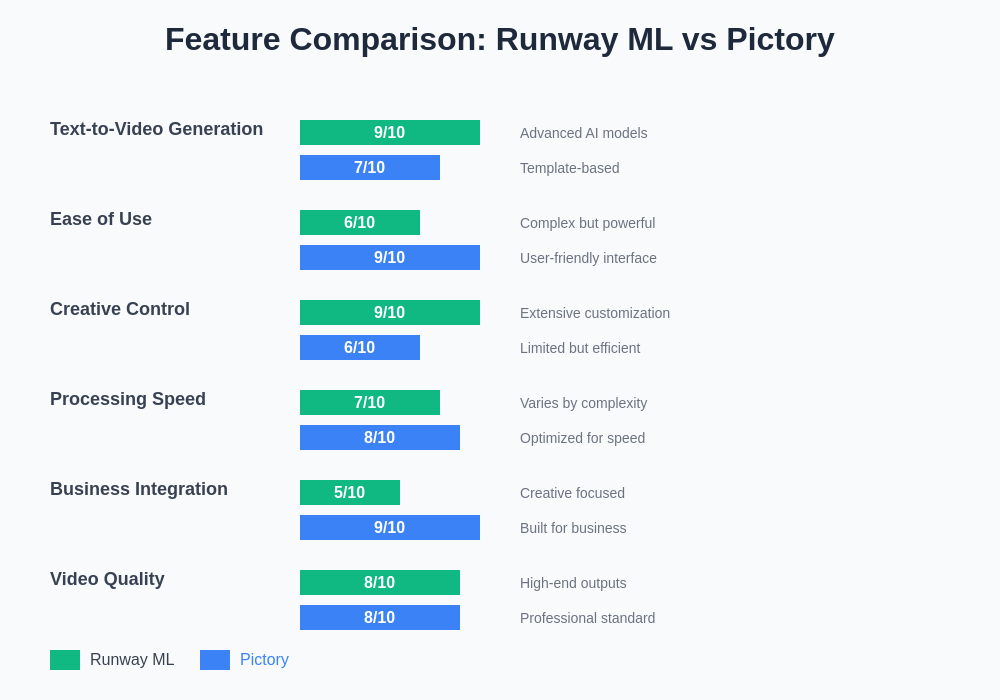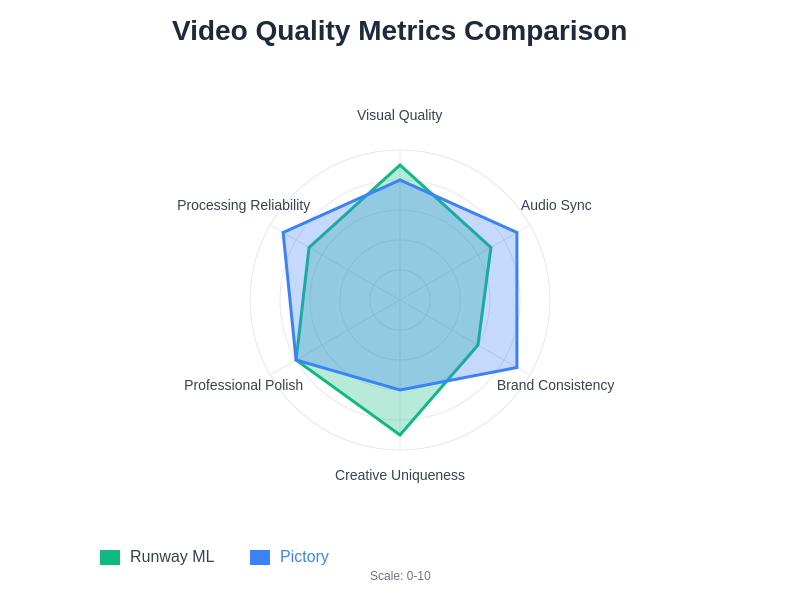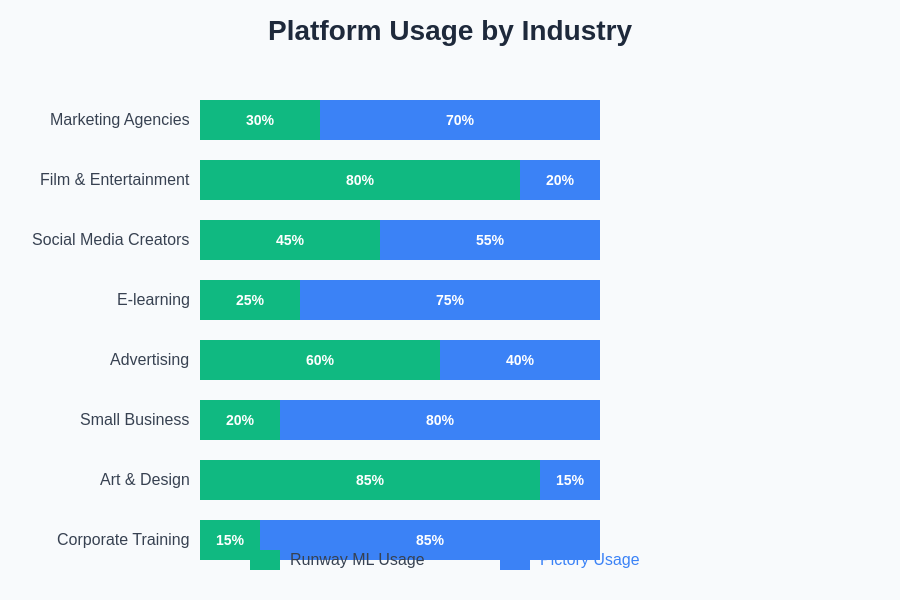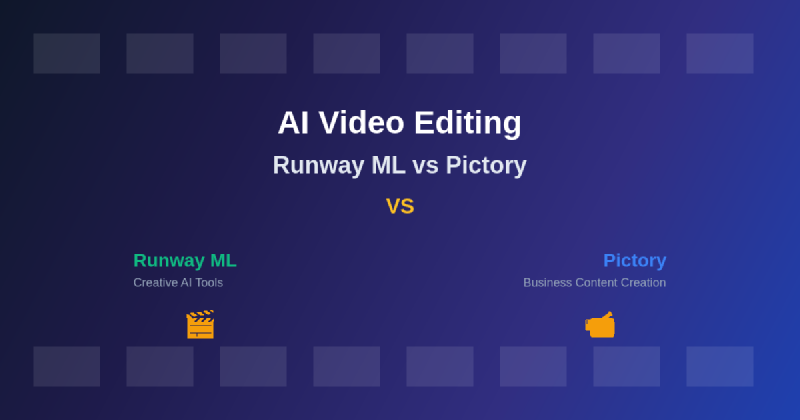The emergence of artificial intelligence in video editing has fundamentally transformed how content creators approach visual storytelling, democratizing access to professional-grade video production capabilities that were once exclusive to expensive studios and specialized teams. Among the pioneering platforms leading this revolution, Runway ML and Pictory stand as two distinct yet powerful solutions that cater to different aspects of AI-driven video creation, each offering unique approaches to automated content generation that have captured the attention of creators, marketers, and businesses worldwide.
Discover the latest AI video trends and innovations to understand how these cutting-edge technologies are reshaping the creative landscape and opening new possibilities for visual storytelling. The competition between AI video editing platforms has intensified significantly, with each solution targeting specific niches within the broader content creation ecosystem while pushing the boundaries of what automated video production can achieve.
Understanding the AI Video Editing Revolution
The traditional video editing workflow has been completely reimagined through the integration of artificial intelligence, moving from labor-intensive manual processes to streamlined automated systems that can produce professional-quality content in a fraction of the time previously required. This transformation has been driven by advances in machine learning, computer vision, and natural language processing technologies that enable AI systems to understand visual narratives, interpret creative intent, and generate compelling video content with minimal human intervention.
Both Runway ML and Pictory represent different philosophies in AI video creation, with Runway ML focusing on experimental AI tools for creative professionals and Pictory emphasizing accessibility and automation for business content creation. These platforms have emerged as leaders in their respective domains, each developing sophisticated algorithms that can analyze content, understand context, and produce videos that align with specific creative objectives while maintaining consistency and quality throughout the production process.
Runway ML: The Creative Professional’s AI Playground
Runway ML has positioned itself as the premier destination for creative professionals seeking cutting-edge AI tools that push the boundaries of what’s possible in video creation and manipulation. The platform offers an extensive suite of AI-powered features including text-to-video generation, video-to-video transformation, motion tracking, object removal, and style transfer capabilities that enable users to create entirely new forms of visual content that would have been impossible or prohibitively expensive to produce using traditional methods.
The platform’s approach to AI video editing emphasizes experimentation and artistic exploration, providing creators with tools that can generate surreal animations, transform existing footage into different visual styles, and create entirely synthetic video content from text descriptions. Runway ML’s text-to-video generation capabilities have particularly captured attention for their ability to create coherent video sequences from simple textual prompts, enabling creators to visualize concepts and ideas without requiring extensive video production resources or specialized filming equipment.
Experience advanced AI capabilities with Claude for comprehensive creative assistance that complements video editing workflows with intelligent script writing, concept development, and project planning support. The integration of multiple AI tools creates a comprehensive creative ecosystem that enhances every aspect of video production from initial concept to final delivery.
Pictory: Streamlined Video Creation for Business Content
Pictory has carved out a distinctive niche in the AI video editing landscape by focusing specifically on business content creation and marketing applications, offering a streamlined approach to video production that prioritizes efficiency, consistency, and scalability over experimental features. The platform excels in transforming written content into engaging video presentations, automatically generating visuals, selecting appropriate music, and creating professional-looking videos that align with brand guidelines and marketing objectives.
The platform’s strength lies in its ability to analyze text-based content such as blog posts, articles, or scripts and automatically generate corresponding video content that maintains narrative coherence while incorporating relevant visual elements, transitions, and audio components. Pictory’s automated approach significantly reduces the time and expertise required to create professional video content, making it particularly valuable for businesses, marketers, and content creators who need to produce large volumes of video content consistently and efficiently.
Feature Comparison and Technical Capabilities
The technical capabilities of Runway ML and Pictory represent fundamentally different approaches to AI video creation, with each platform optimizing for distinct use cases and user requirements. Runway ML offers more than thirty AI tools including advanced features like Green Screen removal, Super-Slow Motion generation, Face Blur detection, and Infinite Image expansion that provide creators with unprecedented control over visual elements and creative possibilities. The platform’s tools are designed for users who want to experiment with cutting-edge AI techniques and create unique visual content that leverages the latest advances in machine learning.
Pictory’s technical approach prioritizes automation and ease of use, with features focused on content transformation, brand consistency, and efficient production workflows. The platform’s AI algorithms excel at analyzing textual content, identifying key themes and concepts, and automatically selecting appropriate visual elements from extensive media libraries. Pictory’s automated video creation process includes intelligent scene transitions, dynamic text animations, and audio synchronization that produces professional results without requiring technical expertise or detailed manual adjustments.

The feature sets of these platforms reflect their target audiences and intended use cases, with Runway ML providing tools for creative experimentation and artistic expression while Pictory focuses on practical business applications and marketing content creation. This fundamental difference in approach means that choosing between these platforms depends largely on specific project requirements, technical expertise, and creative objectives.
The comprehensive feature analysis reveals distinct strengths and optimization priorities for each platform, with Runway ML excelling in creative control and advanced AI capabilities while Pictory demonstrates superior performance in ease of use and business integration aspects that matter most for commercial content creation workflows.
User Experience and Interface Design
The user experience design of Runway ML and Pictory reflects their different target audiences and use cases, with each platform optimizing for distinct workflows and user expectations. Runway ML presents a more complex interface that provides access to its extensive tool suite while maintaining the flexibility required for experimental creative work. The platform’s interface is designed for users who are comfortable with technical concepts and want direct access to AI parameters, customization options, and advanced features that enable fine-tuned control over the video creation process.
Pictory emphasizes simplicity and accessibility in its interface design, presenting users with straightforward workflows that guide them through the video creation process step by step. The platform’s user experience prioritizes efficiency and consistency, with automated processes handling most technical aspects while presenting users with high-level creative choices such as style selection, branding elements, and content structure. This approach makes video creation accessible to users without technical backgrounds while maintaining professional output quality.
Content Creation Workflows and Automation
The workflow differences between Runway ML and Pictory highlight their distinct approaches to AI video creation and automation levels. Runway ML workflows typically begin with creative concepts or existing media that users want to transform or enhance using AI tools. The platform supports iterative creative processes where users can experiment with different AI techniques, combine multiple tools, and refine results through multiple processing stages. This approach provides maximum creative flexibility but requires more time and technical understanding to achieve desired outcomes.
Pictory’s workflow is designed for efficiency and scalability, typically starting with text-based content that the platform automatically converts into video format. The automated workflow includes content analysis, visual selection, audio integration, and final rendering with minimal user intervention required. Users can customize branding elements, select style preferences, and make high-level creative decisions while the AI handles technical aspects of video production, resulting in faster turnaround times and consistent output quality across multiple projects.
Explore comprehensive AI research capabilities with Perplexity for in-depth analysis and insights that inform video content strategy and creative decision-making processes. The combination of research tools and video creation platforms enables more informed and effective content development workflows.
Quality and Output Characteristics
The quality and characteristics of videos produced by Runway ML and Pictory reflect their different optimization priorities and technical approaches to AI video generation. Runway ML’s output quality varies significantly depending on the specific tools used and the complexity of the creative process, with some features producing experimental or artistic results that prioritize innovation over traditional production values. The platform’s text-to-video generation and style transfer tools can create unique visual content that pushes creative boundaries while other tools focus on enhancing existing footage with professional-grade improvements.
Pictory consistently produces videos that meet professional standards for business and marketing applications, with output quality optimized for clarity, consistency, and brand alignment rather than artistic experimentation. The platform’s automated processes ensure that generated videos maintain appropriate pacing, visual coherence, and audio quality while incorporating branding elements and maintaining style consistency across multiple projects. This approach results in predictable, professional output that meets business requirements without requiring extensive post-production work.

The quality characteristics of each platform make them suitable for different types of projects and objectives, with Runway ML excelling in creative and experimental applications while Pictory delivers consistent results for business and marketing content requirements.
The comprehensive quality analysis demonstrates how each platform optimizes for different aspects of video production, with Runway ML showing particular strength in creative uniqueness and visual quality, while Pictory excels in audio synchronization, brand consistency, and processing reliability that are crucial for business applications.
Pricing Models and Accessibility
The pricing structures of Runway ML and Pictory reflect their target markets and usage patterns, with each platform offering different approaches to accessing AI video creation capabilities. Runway ML operates on a credit-based system where users purchase credits that are consumed when using various AI tools, with different tools requiring different credit amounts based on computational complexity and processing requirements. This model provides flexibility for users with varying usage patterns while ensuring that platform resources are allocated efficiently based on actual consumption.
Pictory offers subscription-based pricing with different tiers that provide access to varying levels of features, video generation quotas, and advanced capabilities. The subscription model is designed for consistent usage patterns typical of business and marketing applications, where users need predictable access to video creation capabilities for ongoing content production. Both platforms offer free trials and entry-level options that enable users to evaluate capabilities before committing to paid plans.
Integration Capabilities and Ecosystem Compatibility
The integration ecosystems of Runway ML and Pictory demonstrate different approaches to workflow compatibility and platform connectivity. Runway ML focuses on creative tool integration, offering export options and compatibility with professional video editing software, design applications, and creative workflows. The platform’s tools can be integrated into existing creative processes, allowing users to combine AI-generated content with traditional production techniques and professional post-production workflows.
Pictory emphasizes business tool integration, with capabilities for connecting to content management systems, social media platforms, and marketing automation tools. The platform’s integration approach supports efficient content distribution and campaign management, enabling users to create videos that automatically align with existing marketing workflows and brand guidelines. These integration capabilities extend the platform’s utility beyond video creation to encompass broader content marketing strategies.
Performance and Processing Speed
The performance characteristics of Runway ML and Pictory reflect their different technical architectures and optimization priorities. Runway ML’s processing times vary significantly depending on the specific tools used and the complexity of the requested operations, with some experimental features requiring substantial processing time to achieve high-quality results. The platform’s performance is optimized for quality and capability rather than speed, reflecting its focus on creative applications where result quality takes priority over rapid turnaround times.
Pictory prioritizes processing speed and efficiency, with automated workflows designed to produce videos quickly and consistently. The platform’s performance optimization focuses on enabling rapid content creation that supports business requirements for timely content delivery and marketing campaign execution. This emphasis on speed makes Pictory particularly suitable for high-volume content creation scenarios where consistent turnaround times are critical for operational success.
Target Audience and Use Case Optimization
The distinct target audiences of Runway ML and Pictory have shaped their feature development, interface design, and optimization priorities in ways that make each platform particularly suited to specific types of users and applications. Runway ML targets creative professionals, filmmakers, artists, and experimental content creators who value access to cutting-edge AI capabilities and are willing to invest time in learning complex tools to achieve unique creative results. The platform’s user base typically includes individuals and teams working on artistic projects, experimental content, advertising campaigns, and creative applications where innovation and uniqueness are primary objectives.
Pictory’s target audience consists of business owners, marketers, content creators, and organizations that need to produce professional video content efficiently and consistently. The platform serves users who prioritize practical results over experimental features, focusing on applications such as social media content, marketing videos, educational materials, and business communications where consistency, professionalism, and efficiency are more important than cutting-edge creativity.
Industry Applications and Success Stories
The real-world applications of Runway ML and Pictory demonstrate their effectiveness in different industry contexts and creative scenarios. Runway ML has been adopted by advertising agencies, film studios, independent filmmakers, and digital artists who leverage its experimental capabilities to create unique visual content, prototype concepts, and explore new forms of visual storytelling. The platform’s tools have been used in commercial productions, music videos, art installations, and experimental films where traditional production methods would be insufficient or prohibitively expensive.
Pictory has found success in business applications including marketing departments, educational institutions, social media agencies, and content marketing teams that require consistent, professional video output at scale. The platform’s automation capabilities have enabled organizations to increase their video production capacity, maintain brand consistency across multiple content pieces, and reduce the resources required for video content creation while maintaining professional quality standards.

The industry adoption patterns reflect the platforms’ optimization for different use cases and demonstrate their effectiveness in serving distinct market segments with specialized requirements and expectations.
The industry usage analysis reveals clear patterns in platform adoption, with Runway ML dominating creative industries like film, entertainment, and art, while Pictory shows strong adoption in business-focused sectors such as e-learning, corporate training, and small business marketing where efficiency and consistency are prioritized over experimental features.
Technical Requirements and System Compatibility
The technical requirements and system compatibility considerations for Runway ML and Pictory reflect their different processing approaches and performance optimization strategies. Runway ML’s cloud-based architecture handles most computational requirements on remote servers, reducing local system requirements while requiring stable internet connectivity for optimal performance. Users need modern web browsers and sufficient bandwidth to support video uploads and downloads, but the platform’s cloud processing approach makes advanced AI capabilities accessible to users with standard computer hardware.
Pictory operates entirely in the cloud with minimal local system requirements, focusing on accessibility and ease of use across different devices and platforms. The platform’s technical architecture prioritizes consistent performance and reliability, ensuring that users can access video creation capabilities from various devices without requiring specialized hardware or software installations. This approach maximizes accessibility while maintaining performance consistency across different user environments.
Future Development and Innovation Trajectories
The development trajectories of Runway ML and Pictory suggest continued evolution in different directions that align with their core strengths and target audiences. Runway ML continues to push boundaries in AI research and experimental video creation, regularly introducing new tools and capabilities that leverage the latest advances in machine learning and computer vision. The platform’s innovation focus on cutting-edge AI techniques positions it to remain at the forefront of creative AI applications while expanding its capabilities in areas such as real-time video generation, advanced motion synthesis, and interactive AI tools.
Pictory’s development trajectory emphasizes improved automation, enhanced business integration, and expanded template libraries that support more diverse content creation requirements. The platform’s innovation focus on practical business applications suggests continued development of features that improve efficiency, enhance brand consistency, and provide better integration with existing business workflows and marketing tools.
Making the Right Choice for Your Needs
Selecting between Runway ML and Pictory requires careful consideration of specific project requirements, technical expertise, creative objectives, and resource constraints. Runway ML represents the optimal choice for users who prioritize creative experimentation, unique visual content, and access to cutting-edge AI capabilities, particularly when working on projects where innovation and artistic expression are primary objectives. The platform serves users who are comfortable with technical complexity and willing to invest time in learning advanced tools to achieve distinctive creative results.
Pictory emerges as the preferred solution for users who need efficient, consistent video production capabilities that integrate seamlessly with business workflows and marketing objectives. The platform excels in scenarios where professional quality, brand consistency, and operational efficiency are more important than experimental features or artistic innovation. Organizations requiring scalable video content production, consistent output quality, and streamlined workflows will find Pictory’s automated approach more aligned with their operational requirements.
The decision ultimately depends on balancing creative ambitions with practical constraints, technical expertise with accessibility requirements, and innovation priorities with efficiency objectives. Both platforms continue to evolve and improve their capabilities, making them increasingly valuable tools in the expanding ecosystem of AI-powered content creation solutions.
Disclaimer
This article is for informational purposes only and does not constitute professional advice. The views expressed are based on current understanding of AI video editing technologies and their applications in content creation. Readers should conduct their own research and consider their specific requirements when selecting video editing platforms. The effectiveness of AI video editing tools may vary depending on specific use cases, project requirements, and individual expertise levels. Platform features, pricing, and capabilities are subject to change.
